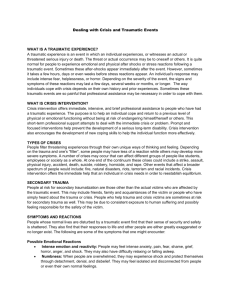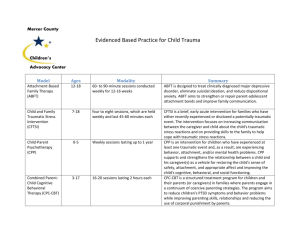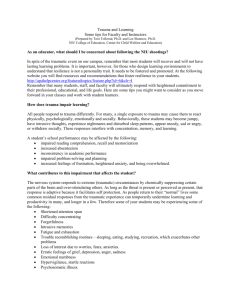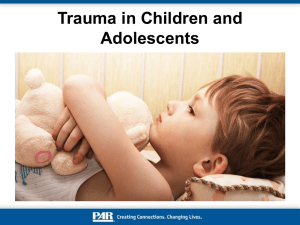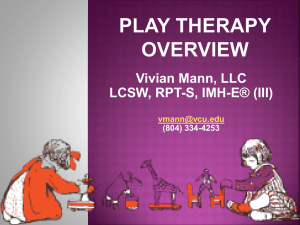000264_609 - The University of West Georgia
advertisement
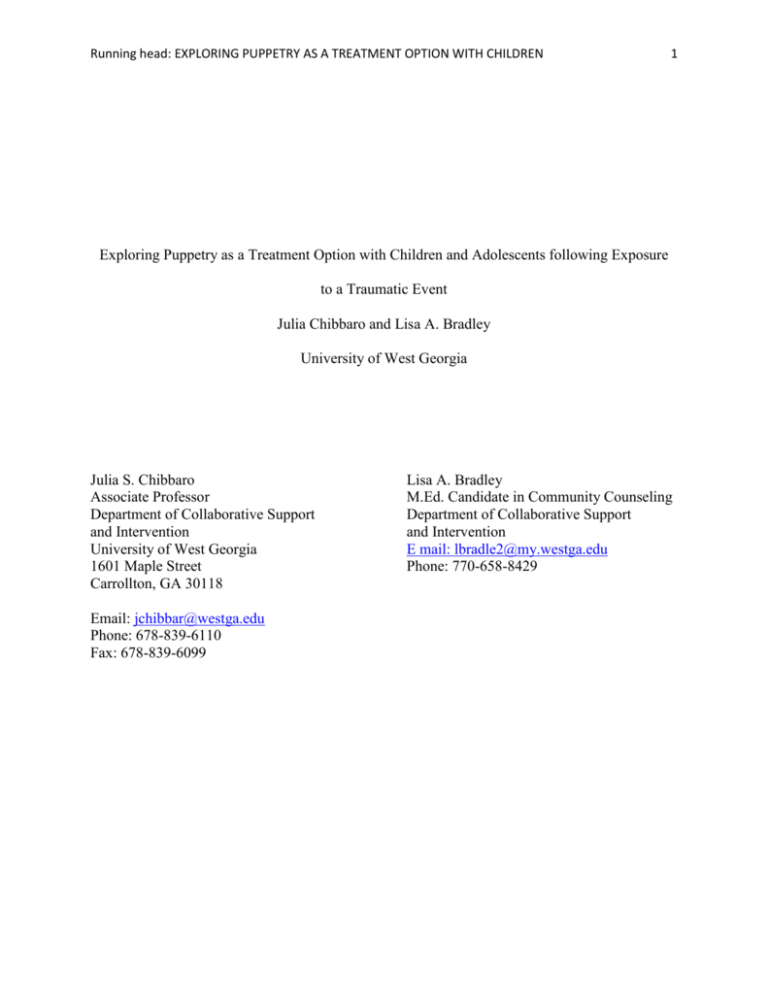
Running head: EXPLORING PUPPETRY AS A TREATMENT OPTION WITH CHILDREN 1 Exploring Puppetry as a Treatment Option with Children and Adolescents following Exposure to a Traumatic Event Julia Chibbaro and Lisa A. Bradley University of West Georgia Julia S. Chibbaro Associate Professor Department of Collaborative Support and Intervention University of West Georgia 1601 Maple Street Carrollton, GA 30118 Email: jchibbar@westga.edu Phone: 678-839-6110 Fax: 678-839-6099 Lisa A. Bradley M.Ed. Candidate in Community Counseling Department of Collaborative Support and Intervention E mail: lbradle2@my.westga.edu Phone: 770-658-8429 Exploring Puppetry as a Treatment Option with Children Abstract The use of play therapy with children and adolescents who have been traumatized is aimed toward helping the child overcome the negative impact of the trauma. The use of puppets in play therapy can be used to help children build and enhance coping skills. This article will explore the effects and treatment of trauma on children and adolescents who have experienced manmade disasters and natural disasters. 2 Exploring Puppetry as a Treatment Option with Children 3 Exploring Puppetry as a Treatment Option with Children and Adolescents following Exposure to a Traumatic Event Each year in the United States over 5 million children and adolescents experience some form of traumatic event (www.ptsd.va.gov). The number of traumatic events over the last decade has been on the increase and range from manmade disasters to natural disasters. Natural disasters can take many forms such as earthquakes, floods, freezing weather and winter storms, hail, hurricanes, tornadoes, other water damage or wildfires. According to National Oceanic and Atmospheric Administration’s [NOAA] National Climatic Data Center, the US has sustained 70 weather related disasters over the past 27 years, and 61 of these disasters have occurred during the 1986-2006 time period. Unfortunately, scientists are predicting there will be a high number of storms over the next ten years (NOAA, 2006). Examples of other man-made disasters include airplane accidents, motor vehicle accidents, shootings, war, and exposure to community violence (www.ptsd.va.gov). Children and adolescents who experience traumatic events may develop future disorders depending upon the individual’s maturation and development (Schwartz & Perry, 1994). This article will explore the effects and treatment of trauma on children and adolescents who have experienced manmade disasters and natural disasters. Following a natural disaster, children typically may experience symptoms such as fear, guilt, sleep and appetite disturbance, self-blame, aggression, loss of interest in school, disturbances in concentration and separation anxiety (Speier, 2000). Depending upon the child’s developmental stage, life experiences, overall emotional and physical health, and parental reactions to the event, the presentation and severity of symptoms will be determined (Vogel & Vernberg, 1993). Many children will recover from experiencing symptomatology, but some children may experience ongoing symptoms which may disrupt their daily lives. Exploring Puppetry as a Treatment Option with Children 4 Trauma impacts children differently depending upon the developmental stage and age at which the traumatic event occurs (Anderson, 2005; Maercker, Michael, Fehm, Becker, & Margraf, 2004; www.ncptsd.org). Younger children who have experienced trauma have suffered severe personality changes and may also experience more generalized fears such as stranger or separation anxiety, sleep disturbances, and a preoccupation with words or symbols that may or may not be related to the traumatic event (Gislasson & Call, 1982; Terr, 1988). They may also engage in magical thinking, in which case they believe they are the cause for the event(s) (Timberlake & Cutler, 2001). Elementary school aged children may experience posttraumatic play or reenactment of trauma in play. Children who exhibit posttraumatic play ritualistically repeat the traumatic theme arriving at the same ending which may lead to psychiatric or behavioral issues (Dripchak, 2007). Reenactment of the trauma involves part of the traumatic event being unconsciously incorporated into the child’s life such as playing the role of the victim, the perpetrator, or bystander of the event (Sadock & Sadock, 2003). In addition, regressive behavior and changes in attitude toward the future with negative expectations have been reported in childhood trauma studies (Pynoos & Nader, 1991). Adolescents who experience PTSD may engage in traumatic reenactment. Adolescents are able to verbalize their reactions to trauma and are also more likely than adults to exhibit impulsive or aggressive behaviors (www.ptsd.va.gov). Jacobs (1999) stated that trauma includes grief reactions and suggested that these need to be released through therapeutic play. There are a number of psychiatric diagnoses that can be found among children and adolescents who have been traumatized. These include major depression, anxiety disorders, panic disorder, substance abuse, PTSD, attention-deficit hyperactivity disorder, oppositional defiant disorder, and conduct Exploring Puppetry as a Treatment Option with Children 5 disorder (Cook, Blaustein, Spinzazzola, & van de Kolk, 2003). To prevent chronic psychopathology, psychological intervention is needed and child mental health care professionals need to be well equipped with techniques and strategies to effectively treat children who suffer from PTSD (Chemtob, Nakashima, & Carlson, 2002). Felix, Bond, and Shelby (2006) describe using puppets to help build and enhance children’s coping skills following a traumatic event. The puppets are used to portray a child character who has been exposed to trauma and whose reactions are described and normalized. Puppets portraying adults are added to the scenario and the child puppet is taken to safety and his or her fears are addressed. Coping skills are emphasized as the child puppet is taught techniques such as deep breathing or positive self-talk. The use of puppets could be ideal for children to create short stories and role play difficult situations brought on by a traumatic event. The creation of a child friendly environment that includes puppets can reinforce a safe place (Baggerly & Exum, 2008). Using puppets, the therapist portrays a story about a character that has experienced a traumatic event. Reactions to the trauma are described and normalized. The goal is to reduce the preservation of any negative thought processes associated with a perceived lack of control (Silva, et al., 2003). An example of such a scenario might be a family losing their home, family dog, and entire belongings to a tornado. Having been displaced, the family relocates to a local shelter for weeks until government funding becomes available. Shortly after settling into a temporary home, the youngest child begins experiencing flashbacks of the night the tornado struck. She begins to have vivid dreams of wind and horror and each time the sky turns gray she runs to the television to get a glimpse of the local weather. She starts to pay particular attention to loud noises and the sounds of wind. She is waiting for the signs of another tornado and believes that if she were aware of Exploring Puppetry as a Treatment Option with Children 6 the signs and paid close attention, she would be able to prevent it from happening again. She also begins to carry a portable weather radio to school. Treatment for the above scenario using a cognitive behavioral (CBT) approach coupled with puppets might look like this. After building rapport with the client (puppets can be used to do this as well), the therapist could discuss the traumatic event with the child asking the child to act out the traumatic events using the puppets; hence exposing them to the traumatic event. After gradually exposing the client, distress and anxiety would likely surface. Anxiety management techniques and correction of inaccurate or distorted trauma related thoughts would come into play (Hamblen, 2004) [www.ncptsd.org]. A variation in this technique could be to have the puppet present with the same problem as the client and to recruit the child’s help in brainstorming solutions to solve the puppets problem (Hall, et al., 2002). An extension of this technique is to have the puppet experience traumatic reminders of the disaster, such as a loud noise or something that was heard during the disaster. The client and the puppet may then practice positive self -talk together (Felix, Bond, & Shelby, 2006). The puppet can even be taken home by the client between sessions to continue to work through the obstacle. Treating children and adolescents who experience traumatic events and develop PTSD continues to present challenges for those working in the counseling profession (Stover & Berkowitz, 2005). Exploring the use of puppetry combined with CBT techniques could provide additional tools for therapists. Further investigation with regard to the feasibility and use of puppetry to treat children and adolescents who develop PTSD is warranted. Exploring Puppetry as a Treatment Option with Children 7 References Anderson, T. (2005). PTSD in children and adolescents. Great Cities Institute publication number GCP-05-04, University of Illinois, Chicago. Baggerly, J., & Exum H. A. (2008). Counseling children after natural disasters: guidance for family therapists. The American Journal of Family Therapy, 36, 79-93. doi:10.1080/01926180601057598 Chemtob, C.M., Nakashima, J., & Carlson, J.R. (2002). Brief treatment for elementary school children with disaster-related posttraumatic stress disorder: A field study. Journal of Clinical Psychology, 58, 99-112. Cook, A., Blaustein, M., Spinzazzola, J. & van de Kolk, B. (Eds.), (2003). Complex trauma in children and adolescents. Washington, DC: US Department of Health and Human Services, National Child Traumatic Stress Network. Dripchak, V.L. (2007). “Posttraumatic play” Towards acceptance and resolution. Clinical Social Work Journal, 35, 125-134. Felix, E., Bond, D., & Shelby, J. (2006). Coping with disaster: Psychosocial interventions for children in international disaster relief. In Schaefer, C.E., & Kaduson, H.G. (Eds.), Contemporary play therapy: Theory, research and practice. (pp. 307-328). New York: Guilford Press. Giglason, I.L. & Call, J. (1982). Dog bite in infancy: Trauma and personality development. Journal of the American Academy of Child Psychiatry, 21, 203-207. Hall, T.M., Kaduson, H., & Schaefer, C.E. (2002). Fifteen effective play therapy techniques. Professional Psychology: Research and Practice, 33(6), 515-522. doi: 10.1037/0735-7028.33.6.515 Exploring Puppetry as a Treatment Option with Children 8 Hamblen, J. (2004). PTSD in children and adolescents. Retrieved from http://www.ncptsd.org/facts/specific/fs_children.html?printable=yes Jacobs, S. (1999). Traumatic grief: Diagnosis, treatment, and prevention. Philadelphia: BrunnerRoutledge. Maercker, A., Micheal, T., Fehm, L., Becker, E., & Margraf, J. (2004). Age of traumatization as a post-traumatic stress disorder or major depression in young women. British Journal of Psychiatry, 84, 482-487. National Center for Post-Traumatic Stress Disorder (n,d.). Impact on small business of natural and manmade disasters. Retrieved from www.pstd.va.org. National Oceanic and Atmospheric Administration (2006). NOAA continues to predict abovenormal hurricane season. Retrieved from www.noaanews.noaa.gov . Pynoos, R. & Nader, K. (1991). Prevention of psychiatric morbidity in children after disaster. In Goldstein, S., Yaeger, J., Heinecke, C., & Pynoos, R. (Eds.), Prevention of Mental Health Disturbances in Children: Washington, DC: American Psychiatric Association Press. Sadock, B.J. & Sadock, V.A. (2003). Synopsis of psychiatry. Philadelphia: Lippincott Williams, & Williams. Schwartz, E. & Perry, B.D. (1994). The post-traumatic response in children and adolescents. Psychiatric Clinics of North America, 17, 311-326. Silva, R.R., Cloitre, M., Davis, L., Levit., J., Gomez, S., Ngai, I., Brown, E. (2003). Early intervention with traumatized children. Psychiatric Quarterly, 74(4). Speier, A.H. (2000). Disaster Relief and Crisis Counseling. Psychosocial Issues for Children and Adolescents in Disasters. Rockville, MD: Center for Mental Health Services. Stover, C.S. & Berkowitz, St. (2005).Assessing violence exposure and trauma symptoms in Exploring Puppetry as a Treatment Option with Children 9 young children: A critical review of measures. Journal of Traumatic Stress, 18,(6), 707-717. Terr, L. (1988). What happens to early memories of trauma? A study of twenty children under age five at the time of documented traumatic events. Journal of the Academy of Child and Adolescent Psychiatry, 27, 96-104. Timberlake, E.M., & Cutler, M.M. (2001). Play therapy in clinical social work. Massachusetts: Allyn and Bacon. Vogel, J., & Vernberg, E.M. (1993). Children’s psychological response to disaster. Journal of Clinical Child Psychology, 22, 70-84. Exploring Puppetry as a Treatment Option with Children Julia S. Chibbaro Associate Professor Department of Collaborative Support and Intervention University of West Georgia 1601 Maple Street Carrollton, GA 30118 10 Lisa A. Bradley M.Ed. Candidate in Community Counseling Department of Collaborative Support and Intervention E mail: lbradle2@my.westga.edu Phone: 770-658-8429 Email: jchibbar@westga.edu Phone: 678-839-6110 Fax: 678-839-6099 Biographical information Julia Chibbaro is an Associate Professor of Counseling at the University of West Georgia, Carrollton, GA. She teaches a course in Play Therapy and is very interested in the use of play with clients. Julia has over 20 years of counseling experience in both school and clinical settings. Lisa Bradley is a mother of three boys, a wife of 20 years, and a recent graduate of the University of West Georgia where she obtained a Maters of Education in Community Counseling. Lisa continues to have a commitment to children and will soon begin her career as a counselor.
